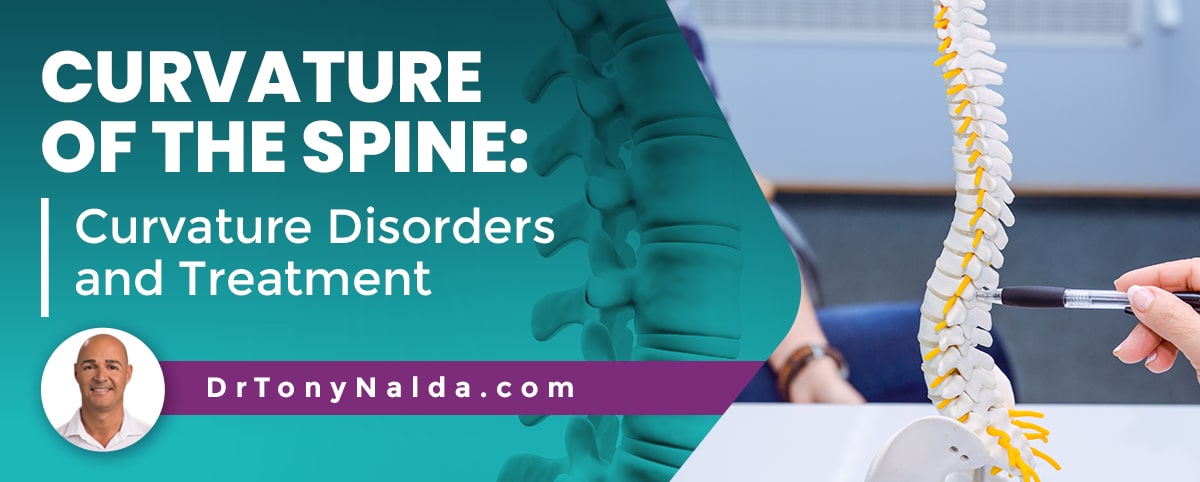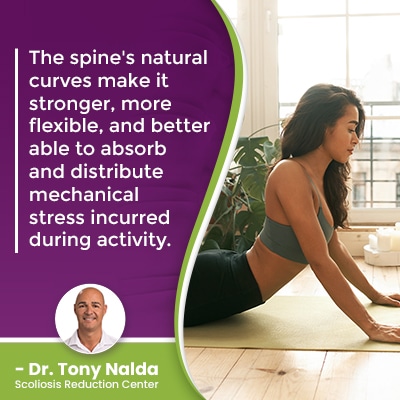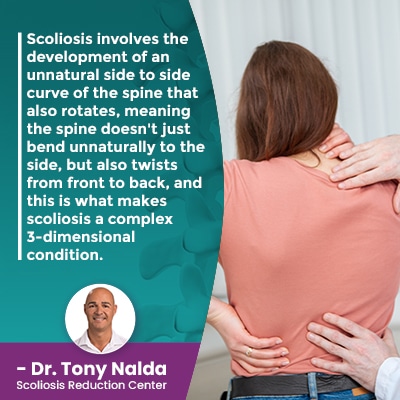Curvature of the Spine: Curvature Disorders and Treatment

As such a complex and important structure of human anatomy, the spine can develop a number of conditions that involve a loss of its healthy curves. As the leading spinal condition amongst school-aged children, and with current estimates at close to seven million people currently living with scoliosis in the United States alone, the condition warrants awareness and discussion.
Scoliosis involves the development of an unnatural sideways spinal curve that also rotates. When it comes to scoliosis treatment options, we're talking about a surgical or non-surgical response; the latter is better for preserving spinal strength and function.
To fully understand how an unhealthy spinal curvature affects the spine, let's make sure we understand the role of the spine's healthy curves.
Table of Contents
Understanding the Spine's Healthy Curvatures
The spine has a soft 'S' shape when viewed from the sides, and when viewed from the front and/or back, it appears straight, and this is because the spine is naturally curved at each of its main sections.
The spine's main sections include the cervical spine (neck), thoracic spine (middle/upper back), and the lumbar spine (lower back).
 The spine's natural curves make it stronger, more flexible, and better able to absorb and distribute mechanical stress incurred during activity.
The spine's natural curves make it stronger, more flexible, and better able to absorb and distribute mechanical stress incurred during activity.
If the spine's natural and healthy curves are in place, this means that its vertebrae (bones of the spine) are stacked on top of one another in a neutral and straight alignment.
In order for the spine to be healthy, strong, and function as it should, it needs to be able to maintain its natural curves and alignment; otherwise, the spine's not as strong, flexible, and can't absorb and distribute stress evenly, leading to uneven wear and tear on the spine.
So now that we understand how the healthy spinal curves work together to preserve spinal strength and function, what happens if one or more of those healthy spinal curves are lost?
Diagnosing Scoliosis
Although there are a number of spinal conditions that involve a loss of the spine's natural curves, diagnosing scoliosis depends on a number of parameters that have to be met, and scoliosis is diagnosed through a physical examination and X-ray results.
 Scoliosis involves the development of an unnatural side to side curve of the spine that also rotates, meaning the spine doesn't just bend unnaturally to the side, but also twists from front to back, and this is what makes scoliosis a complex 3-dimensional condition.
Scoliosis involves the development of an unnatural side to side curve of the spine that also rotates, meaning the spine doesn't just bend unnaturally to the side, but also twists from front to back, and this is what makes scoliosis a complex 3-dimensional condition.
In addition, to be diagnosed as scoliosis, the unnatural spinal curve has to be of a minimum size: Cobb angle measurement of at least 10 degrees.
Cobb angle is known as the gold standard in the assessment/diagnosis of scoliosis and is determined during X-ray by drawing lines from the tops and bottoms of the curve's most-tilted vertebrae, at its apex, and the resulting angle is expressed in degrees.
The higher a patient's Cobb angle, the further out of alignment the spine is, the more severe the condition, and the more noticeable its effects are likely to be:
- Mild scoliosis: Cobb angle measurement of between 10 and 25 degrees
- Moderate scoliosis: Cobb angle measurement of between 25 and 40 degrees
- Severe scoliosis: Cobb angle measurement of 40+ degrees
- Very-severe scoliosis: Cobb angle measurement of 80+ degrees
A key scoliosis condition characteristic to be aware of, along with a number of other spinal conditions that involve abnormal curve development, is that it is a progressive condition; progressive conditions have it in their nature to worsen over time.
In childhood scoliosis, curve progression is triggered by a child's growth.
This means that where a scoliosis is at the time of diagnosis, in terms of severity, doesn't mean that's where it will stay, especially without treatment.
Part of diagnosing scoliosis involves further classifying conditions based on important patient/condition variables, one of which is condition type, and this is determined by causation.
Different Types of Scoliosis
Scoliosis affects all ages from congenital scoliosis that babies are born with, infantile scoliosis, diagnosed between 6 months and 3 years old, early-onset juvenile scoliosis, adolescent idiopathic scoliosis, and adult scoliosis.
The most prevalent form of scoliosis to affect all ages is called idiopathic scoliosis, and the idiopathic classification means not clearly associated with any single-known cause, and adolescent idiopathic scoliosis, diagnosed between the ages of 10 and 18, is the age group most commonly diagnosed with scoliosis.
Approximately 80 percent of known diagnosed scoliosis cases are classified as idiopathic, while the remaining 20 percent are associated with known causes: neuromuscular scoliosis, degenerative scoliosis, and congenital scoliosis.
Neuromuscular scoliosis is caused by the presence of a larger neuromuscular condition such as muscular dystrophy, spina bifida, and cerebral palsy that causes a disconnect between the brain and the muscles, ligaments, and connective tissues that support the spine.
Degenerative scoliosis affects older adults and is caused by natural age-related degenerative changes within the spine, and congenital scoliosis is caused by a malformed spine that develops in utero.
Congenital scoliosis involves birth defects within the spine that occurred as the spine was forming in utero.
There are a number of factors that shape the symptoms of scoliosis, making no two cases the same, but let's talk about the main ways in which scoliosis affects the body as it progresses.
Scoliosis Symptoms and Progression
The main symptom of scoliosis in children is postural deviation related to how the condition's uneven forces disrupt the body's overall symmetry.
Often, the earliest sign of childhood scoliosis can be seen in the shoulders and hips as they become uneven, with one shoulder sitting higher than the other, one shoulder blade protruding more on one side than the other, and uneven hips, with one hip sitting higher than the other.
Additional postural changes can include:
- An uneven eye line
- The head uncentered over the torso
- The development of a rib arch
- uneven waist line
- Arms and legs that appear to hang at different lengths
So as scoliosis progresses, the size of the unnatural spinal curve is increasing, as will the condition's effects, such as postural deviation, and in adults, the main symptom of scoliosis is pain, and that tends to get worse alongside progression of idiopathic scoliosis in adults and in adult degenerative scoliosis.
As scoliosis progresses, the spine gets increasingly rigid, making it less responsive to treatment and more complex to treat, and believe me, it's far simpler to treat scoliosis while mild, rather than after significant progression has occurred.
It's far more effective to proactively work towards preventing progression than it is to work towards reversing its effects once they've developed, but that will depend on the chosen treatment approach.
Treating Scoliosis
When it comes to treating scoliosis, there are two main scoliosis treatment approaches to choose between: traditional and conservative.
Traditional treatment has a more reactive response to a scoliosis diagnosis as it commonly recommends only watching and waiting while mild, but as a progressive condition that's virtually guaranteed to get worse at some point, to me, this is wasting valuable treatment time.
In fact, when scoliosis is mild is the best possible time to start treatment; the spine is still flexible, significant progression hasn't yet occurred, and the body hasn't had time to fully adjust to the unnatural spinal curve's presence.
Because of the traditional approach's reactive response, it does little to prevent progression, but when/if a patient progresses into the severe scoliosis classification, they are commonly funnelled towards spinal fusion surgery.
Spinal fusion has the goal of stopping progression by fusing the curve's most-tilted vertebrae into one solid bone so movement is eliminated and they can't become more tilted over time.
A bone graft is often necessary, and metal rods attached to the spine with pedicle screws hold the spine in place; hardware attached is permanent.
Surgical treatment always comes with risks, but spinal fusion surgery is a costly, invasive, and lengthy procedure that doesn't always improve the health of the spine; in fact, what many patients are most disappointed with is the loss in spinal flexibility and range of motion they are left with.
Fortunately, here at the Scoliosis Reduction Center, patients benefit from a conservative non-surgical treatment response: also known as functional treatment because it strives to preserve as much of the spine's natural strength and function as possible.
Conservative chiropractic-centered treatment integrates different forms of treatment so conditions can be impacted on every level: combining condition-specific chiropractic care that works towards a curvature reduction on a structural level, physical therapy for increasing core strength so the spine is optimally supported by its surrounding muscles, a corrective back brace for augmenting corrective results, and rehabilitation to further stabilize and heal the spine.
Conclusion
When it comes to treating scoliosis, the goal is to prevent the development of severe cases by proactively working towards counteracting progression and increasing condition-effects.
An abnormal curvature of the spine doesn't just affect the spine and its surrounding muscles and nerves, but also the entire body, and while postural changes are the main signs of childhood scoliosis, pain is the main symptom of adult scoliosis; scoliosis becomes a compressive condition once skeletal maturity has been reached.
As progression occurs, the spine gets increasingly rigid and less responsive to treatment, which is why, here at the Center, I start treatment as close to the time of diagnosis as possible when the likelihood of treatment success is highest.
While there are never treatment guarantees, with scoliosis that's detected and treated early, there are fewer limits to what can be achieved.
Dr. Tony Nalda
DOCTOR OF CHIROPRACTIC
After receiving an undergraduate degree in psychology and his Doctorate of Chiropractic from Life University, Dr. Nalda settled in Celebration, Florida and proceeded to build one of Central Florida’s most successful chiropractic clinics.
His experience with patients suffering from scoliosis, and the confusion and frustration they faced, led him to seek a specialty in scoliosis care. In 2006 he completed his Intensive Care Certification from CLEAR Institute, a leading scoliosis educational and certification center.
About Dr. Tony Nalda
 Ready to explore scoliosis treatment? Contact Us Now
Ready to explore scoliosis treatment? Contact Us Now





